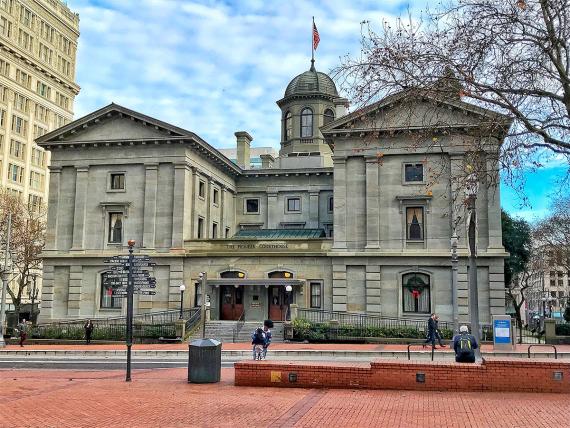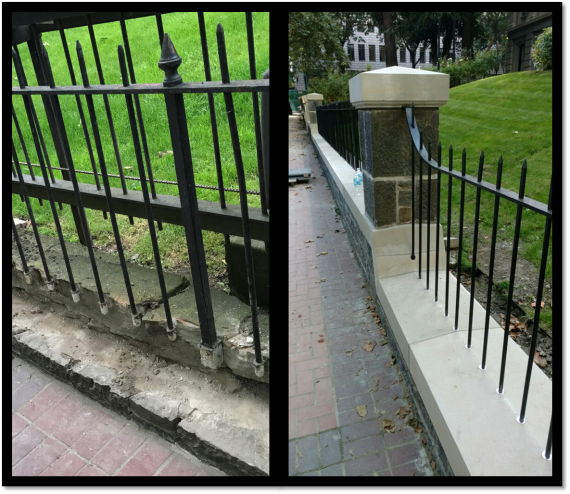GSA breathes new life into Pioneer Courthouse

GSA’s Rebecca Nielsen walks the perimeter of the Pioneer Courthouse in downtown Portland, Oregon, pointing out cracked stone and broken mortar. The weathered sandstone fence surrounding the 142-year-old building had seen better days.
The impromptu tour last spring, just days before new stones would arrive to replace failing and aging ones, was to showcase the urgent need for the repairs.
“Pioneer Courthouse is the jewel in the Region 10 crown. It’s our only National Historic Landmark here and it has a high degree of importance to this community,” Nielsen said, who serves as the Historic Preservation Officer for the Northwest/Arctic Region .
Nielsen walks with GSA Project Manager Terry Martinson, who spends nearly every day of his work week near the venerable courthouse either going to it or passing by, but every time admiring the country’s second oldest federal building west of the Mississippi.
In a few weeks the building would undergo a $1.7 million restoration on its exterior that would extend into the fall of 2017 and result in the on-budget, on-time project completion.
As the two talked of the restoration efforts, they referenced the building as if it were a living, breathing entity. Something certainly more than stone, wood, and glass.
“We’re trying to keep the building alive,” said Martinson as he stood on the building’s eastern steps which once looked out, uninhibited, to the Willamette River where river boats used to slowly roll by. “This isn’t just an old building. It’s an important part of history to the area. It’s our job to ensure it lives on.”
A vein of sandstone at a quarry in Nova Scotia, Canada—some 3,700 miles away, became the source for the new material that would spruce up the old building. More than 300 stones weighing more than 240,000 lbs were trucked to Portland where they were installed.
“We were very lucky to get such a close match to the stone as the original (closer) quarries are no longer operating,” added Nielsen.
The work on this important historical Portland building included restoration, repair, and replacement of the stone belt course and parapet on the western facade. A restoration of all the perimeter wrought-iron fencing, replacement of fence parts such as capstone, piers, and the rebuilding of sections of the perimeter stone wall.

Fast forward some six months later, Martinson, Nielsen, and the contractor would complete the project that bought the old building some new life in an ever-thriving and growing downtown core.
“Pioneer is a backdrop of many Portland public events so we want the courthouse to look its best. We had a great crew and everything went right on schedule,” added Nielsen.
A central point of focus, the Pioneer Courthouse sits geographically in the middle of downtown Portland where it is surrounded by high-rises, a community park, and heavy pedestrian and vehicle traffic, along with the city’s light rail—MAX.
“To say this area is busy is a huge understatement,” added Martinson.
In addition to getting the correct stone, following the state and national historic preservation guidelines, and ensuring the work was done correctly, the project also presented some significant challenges to pull off in the middle of a very active area.
New perimeter fencing to protect pedestrians from work rebuilding major segments of the short stone wall surrounding the project would cut the sidewalk in half. This would force pedestrian traffic closer to rapidly moving vehicle traffic and light rail trains just inches away from the sidewalk edge. This all would occur across the street from a network TV station that uses the Pioneer Courthouse as their backdrop during newscasts.
No pressure, right?
Add to that the noise and inconvenience the project could have on nearby businesses.
The GSA team knew the impact to the area could be substantial so they set out, before construction began, with flyers detailing the upcoming project. Martinson visited with nearby neighbors, small businesses, a major hotel, retail shops, and even the lady who runs a soup cart on one of the corners next to the project.
“They were like, ‘wow, the government is communicating with us,’” said Martinson. “Consensus was won and we had great support for the project.”
Nielsen also met with the Portland Landmarks Commission to ensure they were on board with the project as well.
In addition to the face-to-face effort, GSA built a website that detailed the project and printed its url Pioneer Courthouse on the fabric covering the temporary protective perimeter fencing, giving passersby a place to learn more about the project and the courthouse history.
Martinson attributes the early communication efforts to an outcome that all had hoped for but did not expect—zero complaints.
“Taking the time to be proactive with what was going on, really paid off for everyone,” Martinson added.
The result was a project that all could be proud of and given its prime location the team felt that doing it well would result in some, perhaps, unconventional feedback.
“The highest compliment for this type of historical restoration project is being asked ’so what did you do?’ If the majority don’t see what is done it speaks volumes to the level of craftsmanship and project detail that made this endeavor seamless from the original look,” Martinson said.
PIONEER COURTHOUSE FACTS
The Pioneer Courthouse, built in 1875 and expanded in 1904, experienced its first major rehabilitation in 1973, when it was listed on the National Register of Historic Places. It was designated a National Historic Landmark in 1977.
In 2002, the Courthouse went through a major modernization rehabilitation including building systems, seismic retrofitting and extensive restoration and maintenance of the building’s design. In 2005, and for subsequent years after, the exterior of the courthouse underwent a major stone patching project. Additional patching and work on the fencing is now necessary.
The courthouse is one of four primary locations where the United States Court of Appeals for the Ninth Circuit hears oral arguments. It also houses the chambers of the Portland-based judges on the Ninth Circuit Court of Appeals.

 U.S. General Services Administration
U.S. General Services Administration